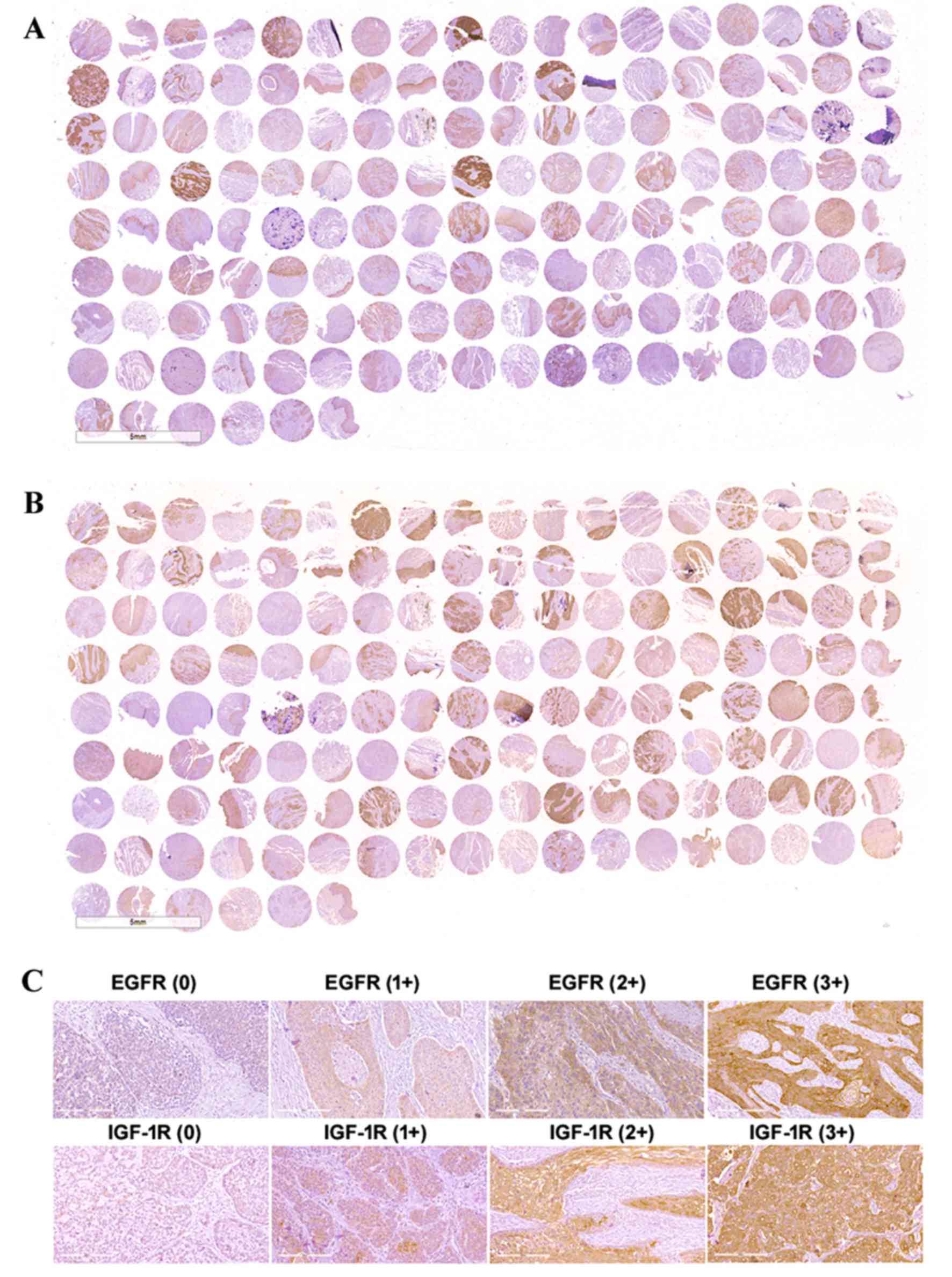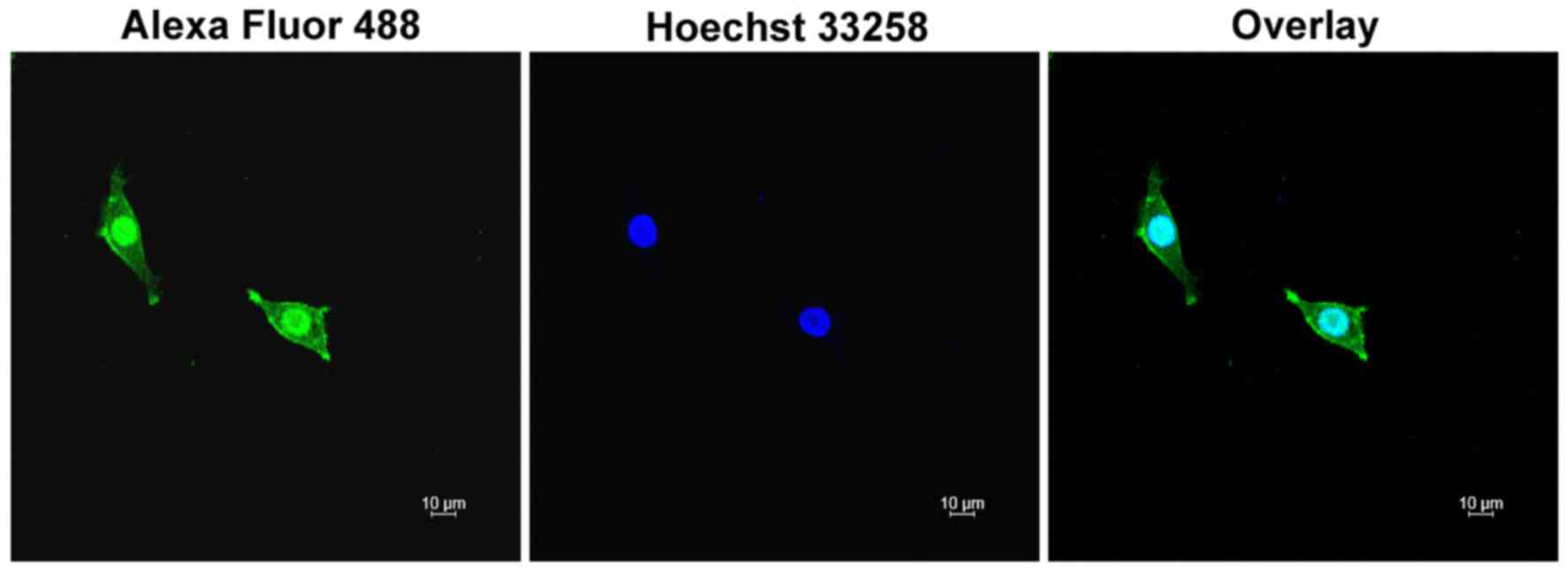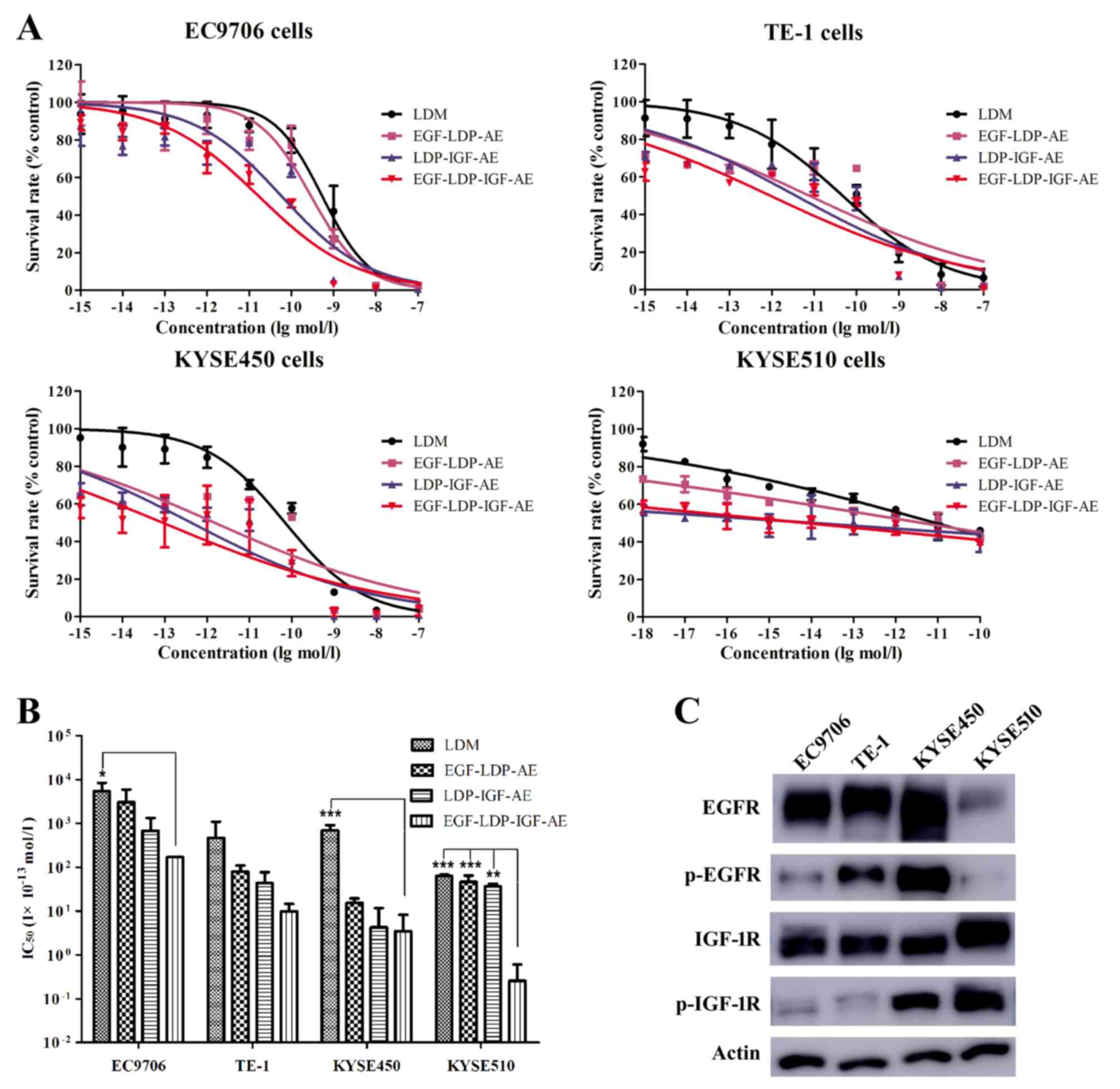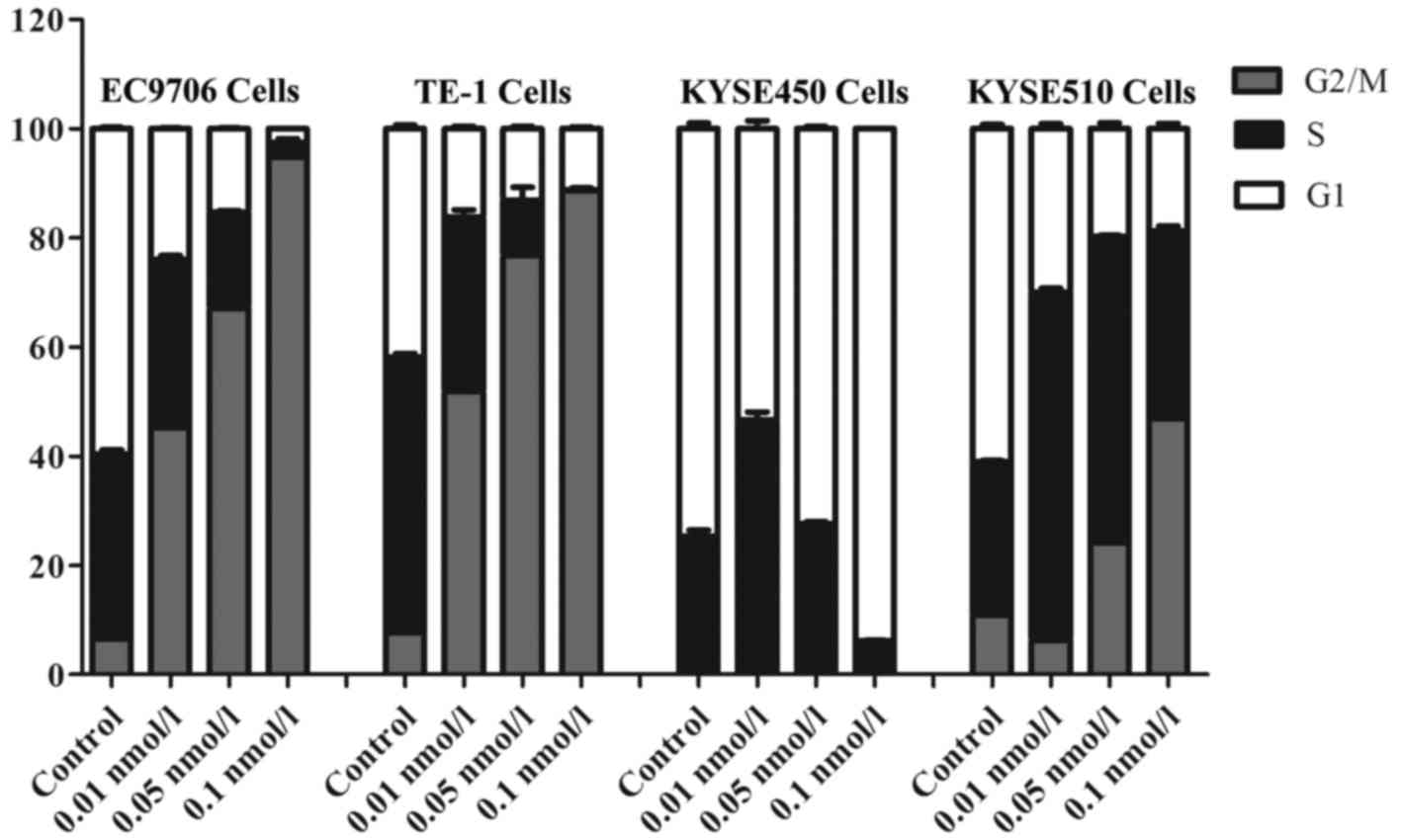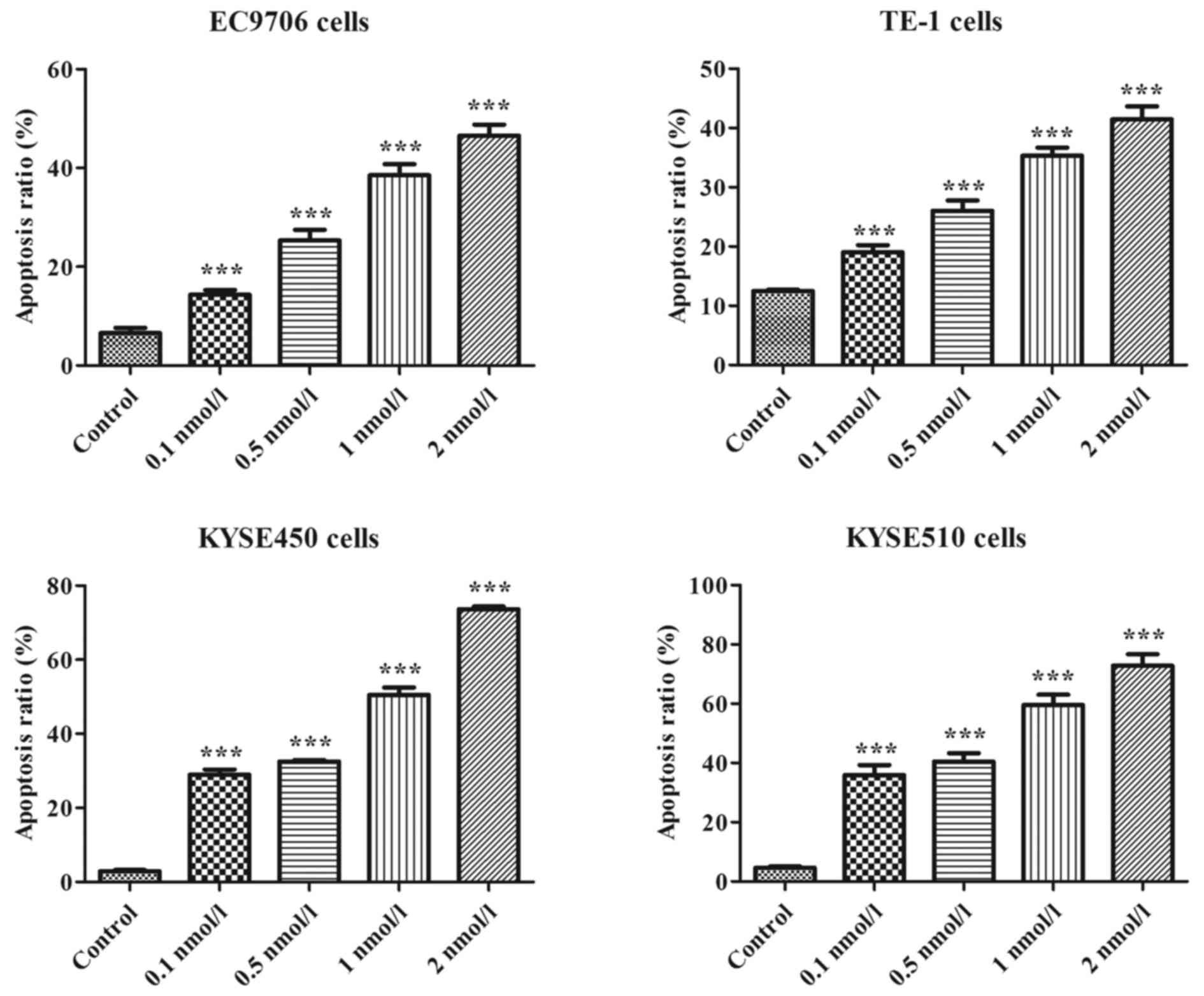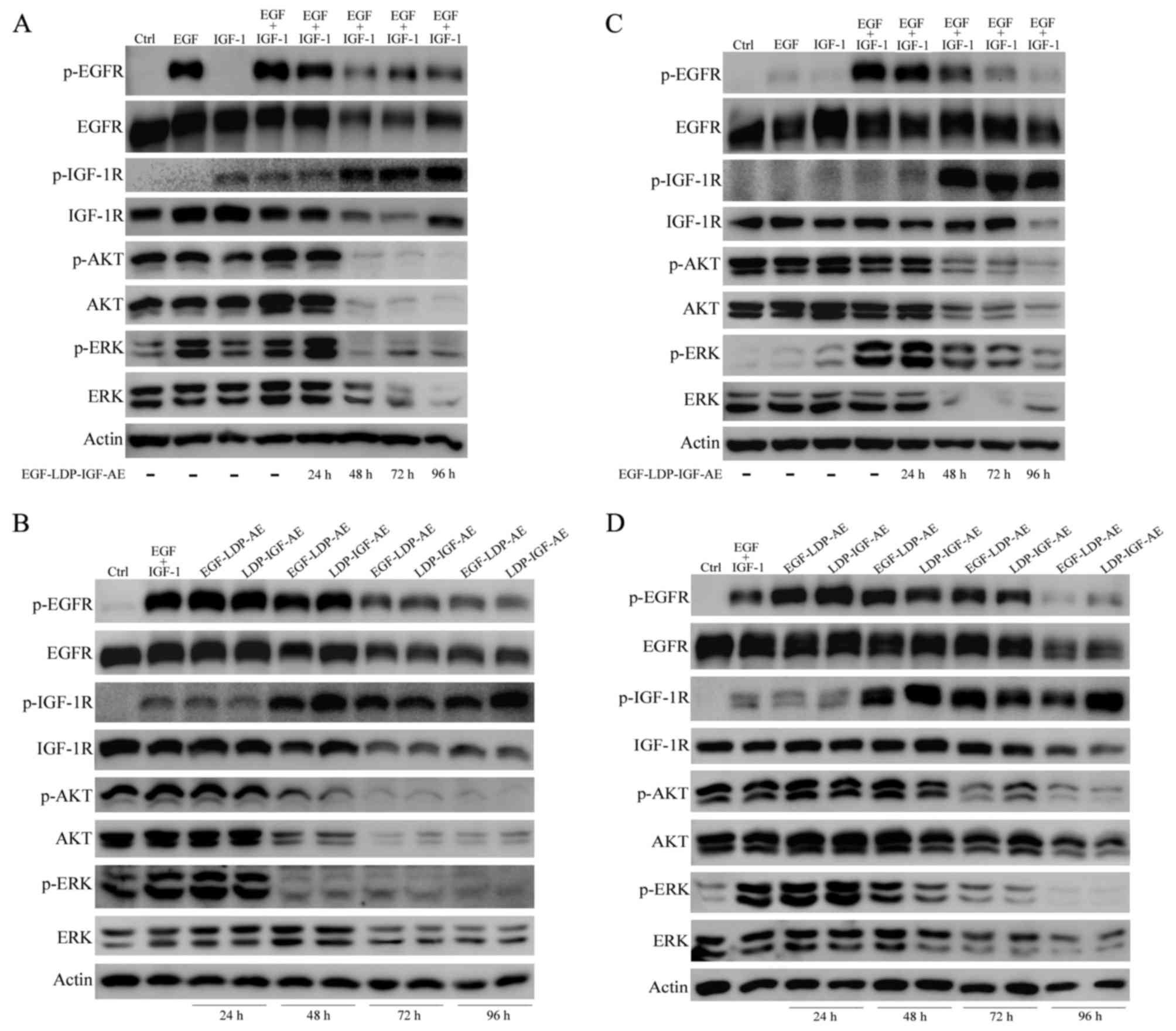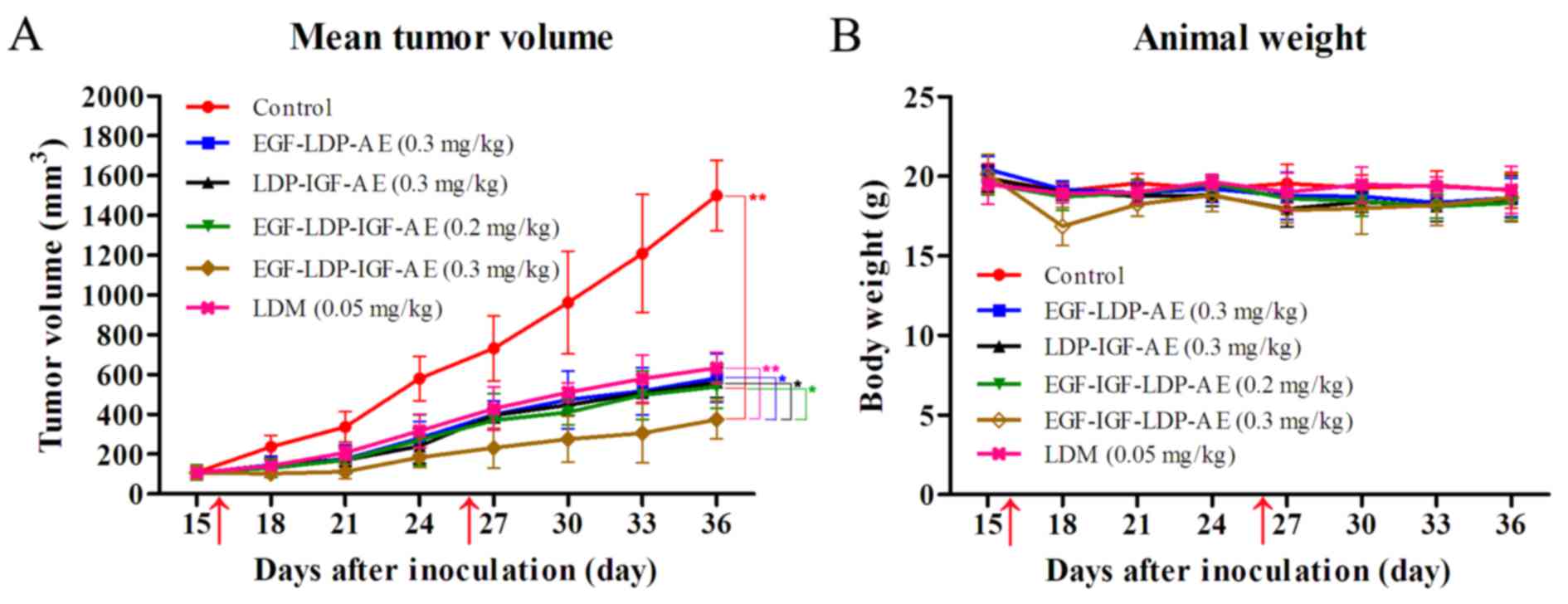|
1
|
Homs MY, Voest EE and Siersema PD:
Emerging drugs for esophageal cancer. Expert Opin Emerg Drugs.
14:329–339. 2009. View Article : Google Scholar : PubMed/NCBI
|
|
2
|
Wang LD, Zhou FY, Li XM, Sun LD, Song X,
Jin Y, Li JM, Kong GQ, Qi H, Cui J, et al: Genome-wide association
study of esophageal squamous cell carcinoma in Chinese subjects
identifies susceptibility loci at PLCE1 and C20orf54. Nat Genet.
42:759–763. 2010. View
Article : Google Scholar : PubMed/NCBI
|
|
3
|
Pennathur A, Gibson MK, Jobe BA and
Luketich JD: Oesophageal carcinoma. Lancet. 381:400–412. 2013.
View Article : Google Scholar : PubMed/NCBI
|
|
4
|
Rowinsky EK: The erbB family: Targets for
therapeutic development against cancer and therapeutic strategies
using monoclonal antibodies and tyrosine kinase inhibitors. Annu
Rev Med. 55:433–457. 2004. View Article : Google Scholar : PubMed/NCBI
|
|
5
|
Hirsch FR, Varella-Garcia M, Bunn PA Jr,
Di Maria MV, Veve R, Bremmes RM, Barón AE, Zeng C and Franklin WA:
Epidermal growth factor receptor in non-small-cell lung carcinomas:
Correlation between gene copy number and protein expression and
impact on prognosis. J Clin Oncol. 21:3798–3807. 2003. View Article : Google Scholar : PubMed/NCBI
|
|
6
|
Oliveira-Silva RJ, de Carvalho A Carolina,
de Souza Viana L, Carvalho AL and Reis RM: Anti-EGFR therapy:
Strategies in head and neck squamous cell carcinoma. Recent Patents
Anticancer Drug Discov. 11:170–183. 2016. View Article : Google Scholar
|
|
7
|
Ooi A, Takehana T, Li X, Suzuki S,
Kunitomo K, Iino H, Fujii H, Takeda Y and Dobashi Y: Protein
overexpression and gene amplification of HER-2 and EGFR in
colorectal cancers: An immunohistochemical and fluorescent in situ
hybridization study. Mod Pathol. 17:895–904. 2004. View Article : Google Scholar : PubMed/NCBI
|
|
8
|
DiGiovanna MP, Stern DF, Edgerton SM,
Whalen SG, Moore D II and Thor AD: Relationship of epidermal growth
factor receptor expression to ErbB-2 signaling activity and
prognosis in breast cancer patients. J Clin Oncol. 23:1152–1160.
2005. View Article : Google Scholar : PubMed/NCBI
|
|
9
|
Sheng Q and Liu J: The therapeutic
potential of targeting the EGFR family in epithelial ovarian
cancer. Br J Cancer. 104:1241–1245. 2011. View Article : Google Scholar : PubMed/NCBI
|
|
10
|
Moorcraft SY and Chau I: Investigational
therapies targeting the ErbB family in oesophagogastric cancer.
Expert Opin Investig Drugs. 23:1349–1363. 2014. View Article : Google Scholar : PubMed/NCBI
|
|
11
|
Yin M, Guan X, Liao Z and Wei Q:
Insulin-like growth factor-1 receptor-targeted therapy for
non-small cell lung cancer: A mini review. Am J Transl Res.
1:101–114. 2009.PubMed/NCBI
|
|
12
|
Adachi Y, Ohashi H, Imsumran A, Yamamoto
H, Matsunaga Y, Taniguchi H, Nosho K, Suzuki H, Sasaki Y, Arimura
Y, et al: The effect of IGF-I receptor blockade for human
esophageal squamous cell carcinoma and adenocarcinoma. Tumour Biol.
35:973–985. 2014. View Article : Google Scholar : PubMed/NCBI
|
|
13
|
Ludovini V, Bellezza G, Pistola L,
Bianconi F, Di Carlo L, Sidoni A, Semeraro A, Del Sordo R,
Tofanetti FR, Mameli MG, et al: High coexpression of both
insulin-like growth factor receptor-1 (IGFR-1) and epidermal growth
factor receptor (EGFR) is associated with shorter disease-free
survival in resected non-small-cell lung cancer patients. Ann
Oncol. 20:842–849. 2009. View Article : Google Scholar : PubMed/NCBI
|
|
14
|
Takahari D, Yamada Y, Okita NT, Honda T,
Hirashima Y, Matsubara J, Takashima A, Kato K, Hamaguchi T, Shirao
K, et al: Relationships of insulin-like growth factor-1 receptor
and epidermal growth factor receptor expression to clinical
outcomes in patients with colorectal cancer. Oncology. 76:42–48.
2009. View Article : Google Scholar : PubMed/NCBI
|
|
15
|
Xu L, Qi Y, Xu Y, Lian J, Wang X, Ning G,
Wang W and Zhu Y: Co-inhibition of EGFR and IGF1R synergistically
impacts therapeutically on adrenocortical carcinoma. Oncotarget.
7:36235–36246. 2016.PubMed/NCBI
|
|
16
|
Valsecchi ME, McDonald M, Brody JR, Hyslop
T, Freydin B, Yeo CJ, Solomides C, Peiper SC and Witkiewicz AK:
Epidermal growth factor receptor and insulinlike growth factor 1
receptor expression predict poor survival in pancreatic ductal
adenocarcinoma. Cancer. 118:3484–3493. 2012. View Article : Google Scholar : PubMed/NCBI
|
|
17
|
Dutton SJ, Ferry DR, Blazeby JM, Abbas H,
Dahle-Smith A, Mansoor W, Thompson J, Harrison M, Chatterjee A,
Falk S, et al: Gefitinib for oesophageal cancer progressing after
chemotherapy (COG): A phase 3, multicentre, double-blind,
placebo-controlled randomised trial. Lancet Oncol. 15:894–904.
2014. View Article : Google Scholar : PubMed/NCBI
|
|
18
|
Chan JA, Blaszkowsky LS, Enzinger PC, Ryan
DP, Abrams TA, Zhu AX, Temel JS, Schrag D, Bhargava P, Meyerhardt
JA, et al: A multicenter phase II trial of single-agent cetuximab
in advanced esophageal and gastric adenocarcinoma. Ann Oncol.
22:1367–1373. 2011. View Article : Google Scholar : PubMed/NCBI
|
|
19
|
Lorenzen S, Schuster T, Porschen R,
Al-Batran SE, Hofheinz R, Thuss-Patience P, Moehler M, Grabowski P,
Arnold D, Greten T, et al: Cetuximab plus cisplatin-5-fluorouracil
versus cisplatin-5-fluorouracil alone in first-line metastatic
squamous cell carcinoma of the esophagus: A randomized phase II
study of the Arbeitsgemeinschaft Internistische Onkologie. Ann
Oncol. 20:1667–1673. 2009. View Article : Google Scholar : PubMed/NCBI
|
|
20
|
Bendell JC, Meluch A, Peyton J, Rubin M,
Waterhouse D, Webb C, Burris HA III and Hainsworth JD: A phase II
trial of preoperative concurrent chemotherapy/radiation therapy
plus bevacizumab/erlotinib in the treatment of localized esophageal
cancer. Clin Adv Hematol Oncol. 10:430–437. 2012.PubMed/NCBI
|
|
21
|
Tebbutt NC, Price TJ, Ferraro DA, Wong N,
Veillard AS, Hall M, Sjoquist KM, Pavlakis N, Strickland A, Varma
SC, et al: Panitumumab added to docetaxel, cisplatin and
fluoropyrimidine in oesophagogastric cancer: ATTAX3 phase II trial.
Br J Cancer. 114:505–509. 2016. View Article : Google Scholar : PubMed/NCBI
|
|
22
|
Krop IE, Lin NU, Blackwell K, Guardino E,
Huober J, Lu M, Miles D, Samant M, Welslau M and Diéras V:
Trastuzumab emtansine (T-DM1) versus lapatinib plus capecitabine in
patients with HER2-positive metastatic breast cancer and central
nervous system metastases: A retrospective, exploratory analysis in
EMILIA. Ann Oncol. 26:113–119. 2015. View Article : Google Scholar : PubMed/NCBI
|
|
23
|
Guo XF, Zhu XF, Cao HY, Zhong GS, Li L,
Deng BG, Chen P, Wang PZ, Miao QF and Zhen YS: A bispecific
enediyne-energized fusion protein targeting both epidermal growth
factor receptor and insulin-like growth factor 1 receptor showing
enhanced antitumor efficacy against non-small cell lung cancer.
Oncotarget. 8:27286–27299. 2017.PubMed/NCBI
|
|
24
|
Shao RG and Zhen YS: Enediyne anticancer
antibiotic lidamycin: Chemistry, biology and pharmacology.
Anticancer Agents Med Chem. 8:123–131. 2008. View Article : Google Scholar : PubMed/NCBI
|
|
25
|
Budwit-Novotny DA, McCarty KS, Cox EB,
Soper JT, Mutch DG, Creasman WT, Flowers JL and McCarty KS Jr:
Immunohistochemical analyses of estrogen receptor in endometrial
adenocarcinoma using a monoclonal antibody. Cancer Res.
46:5419–5425. 1986.PubMed/NCBI
|
|
26
|
Guo XF, Zhu XF, Shang Y, Zhang SH and Zhen
YS: A bispecific enediyne-energized fusion protein containing
ligand-based and antibody-based oligopeptides against epidermal
growth factor receptor and human epidermal growth factor receptor 2
shows potent antitumor activity. Clin Cancer Res. 16:2085–2094.
2010. View Article : Google Scholar : PubMed/NCBI
|
|
27
|
Okita R, Shimizu K, Nojima Y, Yukawa T,
Maeda A, Saisho S and Nakata M: Lapatinib enhances
trastuzumab-mediated antibody-dependent cellular cytotoxicity via
upregulation of HER2 in malignant mesothelioma cells. Oncol Rep.
34:2864–2870. 2015.PubMed/NCBI
|
|
28
|
Wang CJ, Tong PJ and Zhu MY: The
combinational therapy of trastuzumab and cetuximab inhibits tumor
growth in a patient-derived tumor xenograft model of gastric
cancer. Clin Transl Oncol. 18:507–514. 2016. View Article : Google Scholar : PubMed/NCBI
|
|
29
|
Nahta R, Hung MCC and Esteva FJ: The
HER-2-targeting antibodies trastuzumab and pertuzumab
synergistically inhibit the survival of breast cancer cells. Cancer
Res. 64:2343–2346. 2004. View Article : Google Scholar : PubMed/NCBI
|
|
30
|
Larkin J, Chiarion-Sileni V, Gonzalez R,
Grob JJ, Cowey CL, Lao CD, Schadendorf D, Dummer R, Smylie M,
Rutkowski P, et al: Combined nivolumab and ipilimumab or
monotherapy in untreated melanoma. N Engl J Med. 373:23–34. 2015.
View Article : Google Scholar : PubMed/NCBI
|
|
31
|
Hecht JR, Mitchell E, Chidiac T, Scroggin
C, Hagenstad C, Spigel D, Marshall J, Cohn A, McCollum D, Stella P,
et al: A randomized phase IIIB trial of chemotherapy, bevacizumab,
and panitumumab compared with chemotherapy and bevacizumab alone
for metastatic colorectal cancer. J Clin Oncol. 27:672–680. 2009.
View Article : Google Scholar : PubMed/NCBI
|
|
32
|
Stopeck AT, Unger JM, Rimsza LM, LeBlanc
M, Farnsworth B, Iannone M, Glenn MJ, Fisher RI and Miller TP: A
phase 2 trial of standard-dose cyclophosphamide, doxorubicin,
vincristine, prednisone (CHOP) and rituximab plus bevacizumab for
patients with newly diagnosed diffuse large B-cell non-Hodgkin
lymphoma: SWOG 0515. Blood. 120:1210–1217. 2012. View Article : Google Scholar : PubMed/NCBI
|
|
33
|
Dong J, Sereno A, Aivazian D, Langley E,
Miller BR, Snyder WB, Chan E, Cantele M, Morena R, Joseph IB, et
al: A stable IgG-like bispecific antibody targeting the epidermal
growth factor receptor and the type I insulin-like growth factor
receptor demonstrates superior anti-tumor activity. MAbs.
3:273–288. 2011. View Article : Google Scholar : PubMed/NCBI
|
|
34
|
Schanzer JM, Wartha K, Moessner E, Hosse
RJ, Moser S, Croasdale R, Trochanowska H, Shao C, Wang P, Shi L, et
al: XGFR*, a novel affinity-matured bispecific antibody targeting
IGF-1R and EGFR with combined signaling inhibition and enhanced
immune activation for the treatment of pancreatic cancer. MAbs.
8:811–827. 2016. View Article : Google Scholar : PubMed/NCBI
|
|
35
|
Tsai AK, Oh S, Chen H, Shu Y, Ohlfest JR
and Vallera DA: A novel bispecific ligand-directed toxin designed
to simultaneously target EGFR on human glioblastoma cells and uPAR
on tumor neovasculature. J Neurooncol. 103:255–266. 2011.
View Article : Google Scholar : PubMed/NCBI
|
|
36
|
Huang J, Li YM, Massague J, Sicheneder A,
Vallera DA and Hall WA: Intracerebral infusion of the bispecific
targeted toxin DTATEGF in a mouse xenograft model of a human
metastatic non-small cell lung cancer. J Neurooncol. 109:229–238.
2012. View Article : Google Scholar : PubMed/NCBI
|
|
37
|
Oh S, Stish BJ, Sachdev D, Chen H, Dudek
AZ and Vallera DA: A novel reduced immunogenicity bispecific
targeted toxin simultaneously recognizing human epidermal growth
factor and interleukin-4 receptors in a mouse model of metastatic
breast carcinoma. Clin Cancer Res. 15:6137–6147. 2009. View Article : Google Scholar : PubMed/NCBI
|
|
38
|
López-Ayllón BD, de Castro-Carpeño J,
Rodriguez C, Pernía O, Ibañez de Cáceres I, Belda-Iniesta C, Perona
R and Sastre L: Biomarkers of erlotinib response in non-small cell
lung cancer tumors that do not harbor the more common epidermal
growth factor receptor mutations. Int J Clin Exp Pathol.
8:2888–2898. 2015.PubMed/NCBI
|
|
39
|
Rusnak DW, Alligood KJ, Mullin RJ, Spehar
GM, Arenas-Elliott C, Martin AM, Degenhardt Y, Rudolph SK, Haws TF
Jr, Hudson-Curtis BL, et al: Assessment of epidermal growth factor
receptor (EGFR, ErbB1) and HER2 (ErbB2) protein expression levels
and response to lapatinib (Tykerb, GW572016) in an expanded panel
of human normal and tumour cell lines. Cell Prolif. 40:580–594.
2007. View Article : Google Scholar : PubMed/NCBI
|















